Understanding Steem Economy, Its Currencies, and The Reward Distribution System!
When Bitcoin was invented in 2009, people considered it to be just digital cash. But the whitepaper authored by Satoshi Nakamoto didn't declare it just an electronic currency. Bitcoin was invented as an economic system capable of disrupting the existing banking and currency systems. Just like Bitcoin, STEEM is not just a digital currency. It is an economic model capable of disrupting the internet, and it's doing that already. Steemit is just one of the applications built on top of Steem blockchain. There are many which are seeing massive growth already. Utopian and Dtube are good examples of the potential the Steem blockchain has. SMTs will only multiply its effectiveness.
But how does the economic system of Steem work? What are its currencies? Where do they come from? These are some of the questions this post will answer in detail. Understanding the benevolent economy of Steem will be beneficial for an enhanced experience on Steemit or any other application powered by Steem.
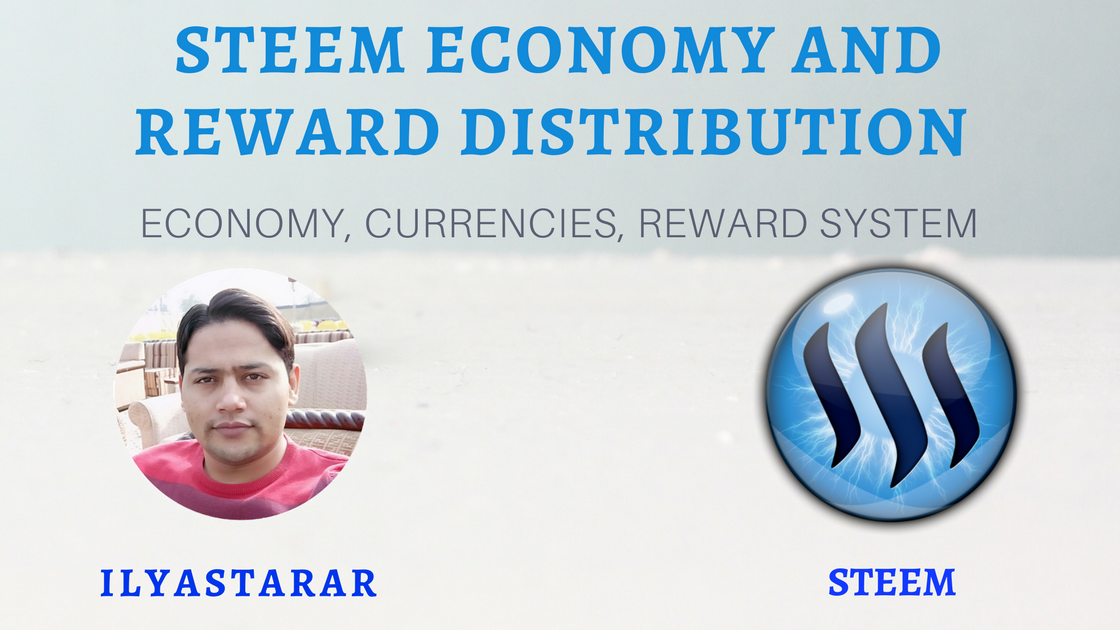
Image is designed by me via free online tool Canva.com
There are many questions related to Steem's economy and its reward system. It get a lot of questions and I have observed that there is a lot that needs to be clarified. Here are some common questions about the economics of Steemit.
- How does Steemit reward its users?
- Where does the money for the rewards come from?
- Why does Steemit reward in the first place?
- What are Steem, Steem Dollar and Steem Power?
- How much money will I get?
- How the heck does the whole reward system work?
There are many confusions regarding Steem reward structure. With this post, I am trying to remove majority of these confusions. I am sure this post will help current Steemians, and future generations of Steemit users to understand Steem economy better and benefit from that understanding.
Let's begin with the currencies of the Steem economy.
Currencies of Steem
There are three currencies in your Steemit wallet; Steem, Steem Power and Steem Dollars. Let's see what they are.
STEEM
It is a cryptocurrency token, similar to Bitcoin. Steemit is based on Steem blockchain (like Bitcoin has its own blockchain). STEEM token is the cryptocurrency of Steem blockchain. On Steemit, it can be powered up into Steem Power, traded for Steem Dollars, and transferred to other accounts. On exchanges like Binance, Bittrex and Poloniex, it can be traded just like any other cryptocurrency coin.
STEEM POWER (SP)
Abbreviated SP, Steem Power is basically, what I prefer to call it, frozen STEEM. It is STEEM that is vested into the platform and does not remain liquid (immediately trade-able) once vested. It is the standard measurement of how much influence a user has in the Steem network. The more Steem Power a user holds, the more they can influence the value of posts and comments they upvote. The more value their upvote has, the more curation rewards are also earned.
STEEM DOLLAR (SBD)
Steem Dollar is abbreviated SBD (Steem Blockchain Dollar or often called Steem Backed Dollar). It is liquid, stable-value currency tokens designed to be pegged to $1 USD (but difficult to prevent a breach of the peg at the moment). SBD is basically a token value of which is deigned to remain equal to one USD of STEEM value (explained later). Steem Dollars can be traded with STEEM, and transferred to other accounts for commerce or exchange.
If you want to know more about these currencies, this video by @andrarchy will help you.
To study the role of Steem Dollars, this post by @dragosroua will definitely help. Some accounting knowledge may be prerequisite to understand the whole concept. I did not fully understand initially but now I get it better after attending a course on financial accounting.
Why Does Steemit Reward Its Users?
Let's talk about Bitcoin. Bitcoin is created and stored by its blockchain. It is created when powerful computers solve complex mathematical problems. The process is called mining and the concept of earning Bitcoin through mining is called Proof of Work.
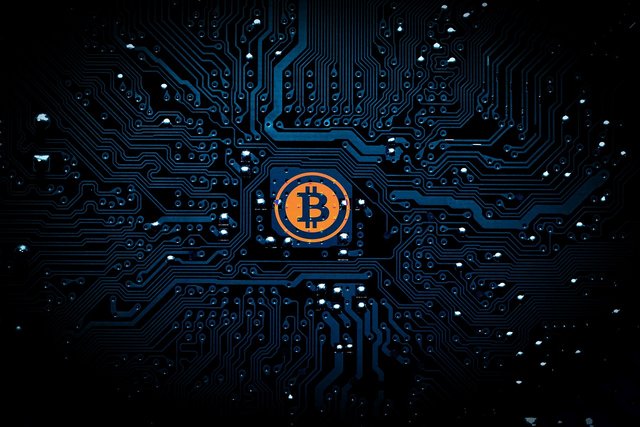
Source: Pixabay
So, mining is work. When this work is done, Bitcoin is created. Let's come to Steem now. By content creators, Steem is earned through Proof of Brain. There are two ways of earning Steem using your brain, which are briefly mentioned below.
- Author Rewards: When you publish a post or a comment and other users upvote it, you earn author rewards.
- Curation Rewards: When another author publishes a post or comment and you determine it to be valuable enough to upvote it, you get rewarded a share of the value of your upvote as curation reward. But to gain considerable curation rewards, you need to have Delegated Proof of Stake in the platform.
Creating content and upvoting content based on its quality both are activities done using the brain, hence Proof of Brain. So, Steemit rewards the use of brain (and I personally love the concept!). But to reward other users, or even yourself, you need to have Delegated Proof of Stake (DPoS). The amount of STEEM that you power up becomes your vested share in the blockchain. It is your stake that you have delegated to the blockchain to have an influence. This influence is the value of your upvote.

Contrary to Bitcoin and other blockchains, which store only the currency and its transactions, Steem blockchain stores content too. All the text content published on Steemit is permanently stored on the blockchain. It is immutable, meaning you cannot delete it from the blockchain, even if you delete it from the website. Whenever you create or upvote content, you actually are doing a transaction on the Steem blockchain and that transaction is permanently stored.
- The immutability means total freedom from censorship.
- The upvote system means decentralization and power in your hands.
- Proof of Brain means you can
mineSteem with your brain.
Due to the unique reward system and censorship proof social media platform characteristics, Steemit.com holds an edge to become the world's most attractive social media / blogging website. Despite having been around for two years now, the website is still in beta and improvements are being made frequently.
To answer the "why" part, let me give conclusive answers and move forward to the next part.
- Steemit rewards its users to incentivize content creation and curation.
- The use of STEEM as the incentive currency and token of influence on the website increases its value; thus making multi-million dollars for the founders and share holders (investors) of Steemit.
- Rewarding users attracts more users to the website, thus making Steemit popular. It is among the top 1000 websites in the world.
- Steemit has the potential to cross Reddit and Facebook in popularity and become the face of internet. By incentivizing use of brain and intellectual activity, Steem is helping itself become great.
- STEEM is vested (frozen) in the form of Steem Power by users to have more influence (power up) which locks Steem on the platform and decreases available trade-able Steem; causing an increase in value.
These are some of the main reasons I wrote from my perspective. I know you can be a lot more creative so do suggest more uses in the comments. Meanwhile, we move ahead.
It would be useful for you to read Steem's bluepaper.
Where Does Steem Come From?
This is one of the most frequently asked questions. I hope to clarify this matter once and for all. As we know that the cryptocurrency of Steem blockchain is STEEM. Where does Steem come from? Steem is not mined. It was mine-able initially but the mining was stopped by Steemit Inc. All the Steem in circulation or supply is pre-mined except a small percentage which is created annually through inflation (release of new tokens). I know you may be struggling to understand it so far but let me briefly explain where Steem comes from.
- The Steem that is already available on exchanges and Steemit is premined. It means that it was created by Steem blockchain and exists already. Total supply of Steem right now is 271,573,105 tokens of Steem at the time of writing. These Steem tokens can be bought from popular exchanges like Binance, Bittrex, and Poloniex. Steem is traded on these crypto exchanges just like other altcoins.
- However, the already existing Steem are not given to Steemit authors and curators. Steemit users are rewarded tokens from Reward Pool which is a result annual inflation. Starting from December 2016, every year a percentage of new Steem tokens are created (a process called inflation) and allotted to the reward pool. Current inflation rate is 9 % and an annual decrease of approx 0.5 % is planned annually until the inflation rate drops to just 0.95 % in about 19 years time.
- The tokens created via annual inflation are released daily in form of daily reward pool, from which authors and curators are rewarded.
We can deduce two things from the above information. One is that the rewards we get from the reward pool are result of annual inflation. The second thing, and the more prominent one, is that there always will be a reward pool, no matter how small. However, a smaller reward pool would mean less inflation and thus more value per token.
We Get Steem From Inflation, But Where Does the SBD Come From?
Steem Dollars are part, and not the whole, of the author payouts for the posts and comments (content). However, curation rewards are paid only in SP. Author payouts is where SBD comes into play and also in the wallet where it is stored after the payout is finalized.
- Why is Steem Dollar even on Steemit?
- Why not only Steem?
- What is the purpose and use of Steem Dollars?
- Where does it come from?
Steem's blue paper on Steem.io website pretty much sums up why Steem Dollars were needed on Steemit. Why was SBD needed as a currency on Steemit? Here's the answer.
In order to help bridge the gap between more traditional fiat money systems which mainstream users are used to, and the cryptocurrency tokens which they are awarded through the platform, a new currency called Steem Blockchain Dollars (SBD) was created.
And this part explains the purpose of Steem Dollars.
SBD tokens are designed to be pegged closely to one USD, so that users who receive them can know approximately how much they are worth in “real dollar” terms. SBD tokens also offer a relatively stable currency for users to hold if they are looking to preserve their account value relative to USD.
Steem's technical whitepaper speaks at length about the purpose of introducing SBD on Steemit.
Because stability is an important feature of successful economies, Steem Dollars were designed as an attempt to bring stability to the world of cryptocurrency and to the individuals who use the Steem network. Steem Dollars are created by a mechanism similar to convertible notes, which are often used to fund startups. In the startup world, convertible notes are short-term debt instruments that can be converted to ownership at a rate determined in the future, typically during a future funding round. A blockchain based token can be viewed as ownership in the community whereas a convertible note can be viewed as a debt denominated in any other commodity or currency.
And about creation of Steem Dollars, the Steem whitepapers maintains anonymity.
The blockchain decides how and when to create SBD and who should get it. This keeps the rate of SBD creation stable and removes most avenues of abuse.
We can say that the SBD was created to bring stability to the platform, alongwith giving its users a sense of what USD (due to its popularity) value their content is earning for them because SBD is pegged to 1 USD.
But my understanding is that the quantity of SBD totally depends on price of Steem. If the price rises, value of upvotes rises for everyone, which means that post payouts also increase (the amount with $ sign). Whatever the amount is shown with the $ sign (post/comment rewards), at least 37.5 % of its amount is paid in form of SBDs. So, there is a direct relationship between Steem's price and the number of SBDs created to be paid to authors.
For detailed study, read the Steem technical whitepaper.
Where Does Steem Power Come From?
Steem Power is basically Steem vested in Steem blockchain. It can come from multiple sources but we will restrict our discussion strictly to Steemit.
A quick calculation is needed to clarify rewards distribution briefly. Suppose your post shows $100 reward. Upon payout, you (author) will only get 75 % of it (that too half in SBD and half in SP). Rest of the 25 % is converted to SP and distributed among people who upvoted your post (curators). For $37.5 (half of 75 %), you get exactly 37.5 SBD. The other $37.5 are converted into SP as per current USD price of Steem (you get as SP whatever number of Steem can be bought with 37.5 USD).
On Steemit, you get Steem Power in three ways.
- Author Rewards: As explained above, 37.5 % of your author rewards are converted to SP and paid to you.
- Curation Rewards: As mentioned earlier, people who upvote (curate) your content get a share out of 25 % of your post payout.
- Power Up: Power Up is a process of increasing your influence on the platform by vesting your Steem into the blockchain. Steem can be bought from internal or external exchanges.
You can also get delegated SP but you do not own it. But it definitely increases the value of your vote. I will do a separate post on it too. That's it for the basics of Steemit economy and the working and purpose of Steem blockchain's currencies. I hope you understood all the important aspects of Steemit economy and a basic idea of how the rewards system works.
Having covered the currencies of Steem blockchain in detail, it is time to see how rewards are distributed on the Steem based applications.
Three Things to Know About Steemit Rewards Distribution
Before going into the details of the actual distribution, there are three things about the rewards that you need to know. All of them are briefly discussed below.
1. Rewards are Shown in One Currency Only
This seems simple but it is not. All the rewards on your posts and comments are shown with an amount preceded by $ sign. This $ sign means US dollars (USD) but in actuality, its value can be much less or more (currently more) than what the shown amount is. I will explain later.
For now, just remember that Steem blockchain used $ sign because it was logical to do so. However, for the best part of many months now, the actual USD value of Steemit rewards has been much more than the $ sign shows. It will also be explained.
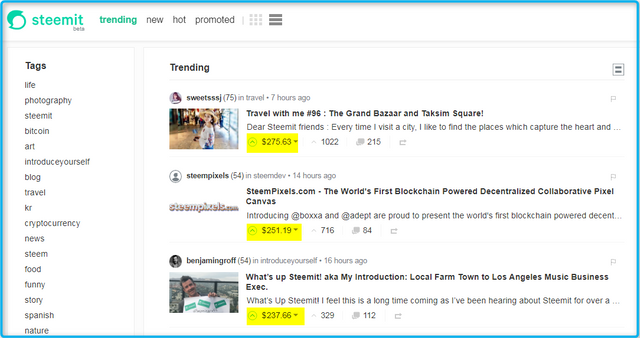
The amount mentioned with $ sign is not what you will be paid. But it determines what you get. Your rewards will be converted to Steem Power (SP) and Steem Dollars (SBD) depending on whether you want both or just the SP. Again, everything is explained in the post.
2. Rewards are Paid in Two Currencies
This is where things get a little complicated for innocent minnows and new fishes. The rewards, which are shown with $ , are paid (sent to your wallet) in two currencies; Steem dollars (SBD) and Steem Power (SP). How this division is done will be explained a little later in this post.
3. Rewards Can be Converted to All Three Currencies
Things get way complicated here but it's basically pretty simple. You get SBD and SP as reward from posts, comments and curation (the upvotes you do on others' posts). The only currency that remains is Steem.
- Well, you can buy Steem directly from the internal market against SBD. You pay in SBD and get Steem in your wallet.
- To convert SP into SBD or Steem, you'll have to go through a process called Powering Down. It is so named because powering down decreases your influence and value of your upvotes.
- When you start power down, SP is converted to Steem in 13 equal installments over a period of 13 weeks, starting one week from the time the operation starts. It can be cancelled any time.
- To convert SP into SBD, first you'll have to power down to Steem and then sell Steem for SBD in the currency market.
This broader understanding of Steem, Steem Dollar and Steem Power will help you understand the next part where exact distribution of these rewards is explained.
The Actual Steemit Rewards Distribution : Amounts, Percentages & Value
If you think you had enough twisting already, think again. You're in for another round of clarifying your doubts about rewards. Let's get over with this reward thing once and for all.
Rewards are Shared Between Authors and Curators
The amount in $ that you seen on your posts and comments is divided as follows.
- At least 75 % of the amount goes to the author i.e. you.
- At most 25 % of the amount is distributed among the curators; the people who upvoted on it.
The phrases at most and at least have some significance which is explained later in the post. To exemplify the above distribution, let me show you the final payout distribution on one of my recent posts. In the screenshot below, the final payout on this post is shown.
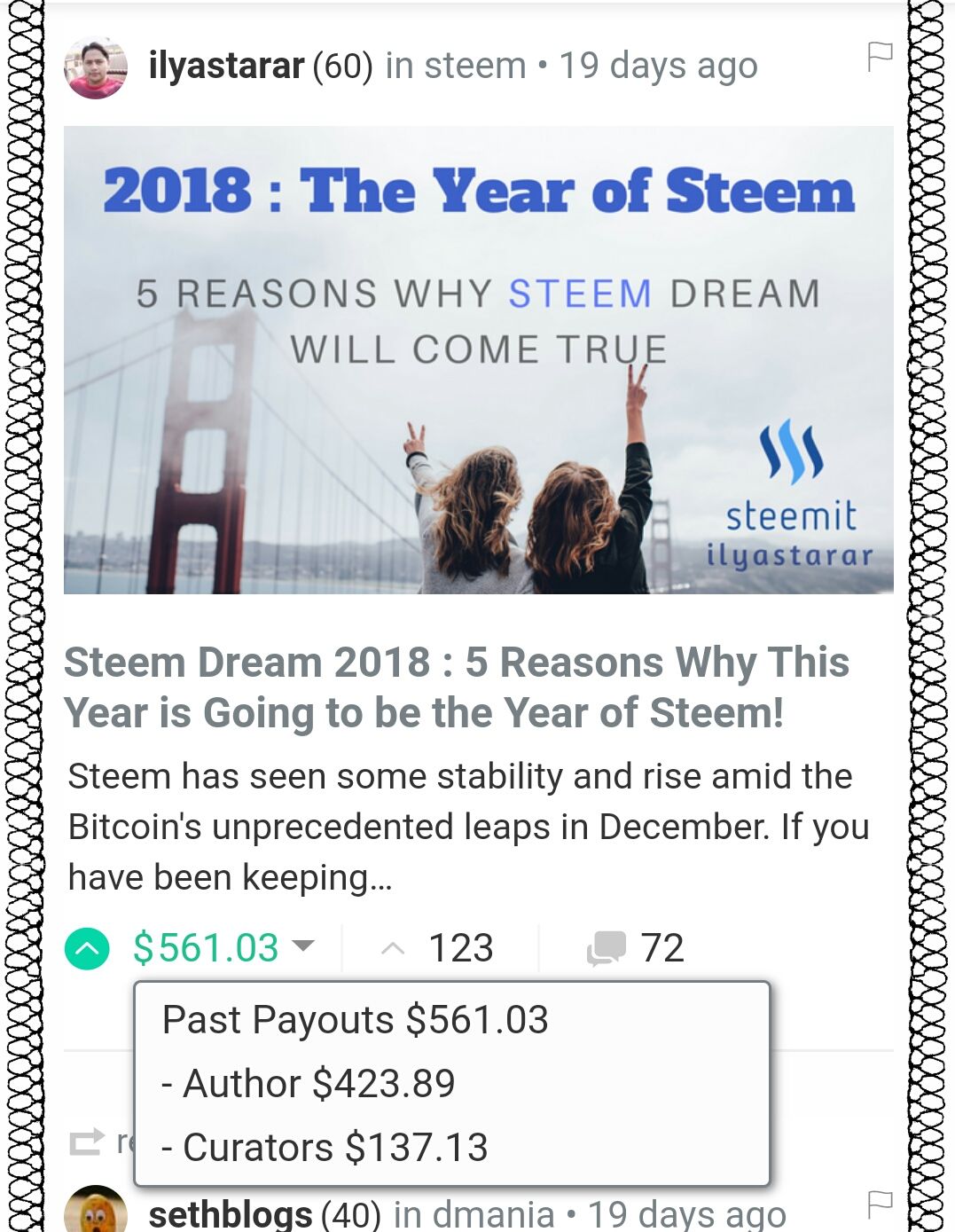
You can clearly see how the reward has been distributed between author and curators. Let's do some math to verify the percentages.
- Total Amount = $561.03 (Amount is the total number of SBD the post would have earned if 100 % reward was paid in SBD)
- Author Share = $423.89 (Doing the math, 423.89 is just almost 75 % of 561.03)
- Curators Share = $137.13 (Which is just less 25 % of the payout amount)
Clear till here? The final thing you need is the final disbursement of author and curators rewards to the respective wallets. The process needs some serious mathematics and may not be as simple as getting 75 % of the post payout.
But after enhancing your knowledge about the final disbursement of rewards into your wallet, you will be able to decide what options you want to choose for you and it will help you calculate your profits from the popular voting bots as well, if you use any.
How The Share of Authors is Paid?
There are two important facts that we established till now about rewards.
- Steemit rewards are paid in two currencies; SBD and SP.
- 75 % reward from the posts or comments goes to the author.
Keep these in mind. They are useful for further discussion. Author rewards are rewarded as per the option chosen by the users so it is logical to discuss those options alongside the distribution. Remember, what you get as payout depends on what payout option you have chosen.
Note:- These days, you can see Steem being rewarded as well. This is "because the debt to equity ratio - the amount of SBDs compared to the value of STEEM in circulation, went above 2%."
How Author's Share Translates to SBD and SP?
When you write a post, you may have noticed a small option with the name of Rewards. After it is a box normally saying Default (50 % / 50 %). When you click the box, some options come up. See the image below.
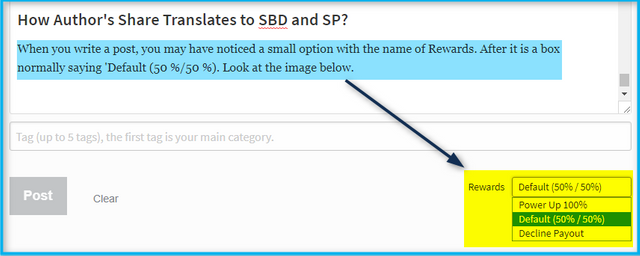
The default option is most common as it distributes the whole reward into SBD and SP. I'll explain which option to choose. For now, let's start doing maths to find out reward distribution.
- Suppose (just like in all those math books), one of your post shows $100 reward. Now, if you're using default option, the distribution will be as follows.
- Reward gets divided into authors and curators in 75 % / 25 % ratio. You have $75 left as author reward. This $75 will be paid out as Steem Dollars and Steem Power. The process is explained below.
Now, if you're using default option, your $75 will be divided in to two equal parts; in SBD and SP (50 % / 50 %). Let's study each of them.
- SBD: Default option means you'll get 37.5 SBD (50 % of $75) in your wallet. So, your payout will be 37.5 SBD, other than the SP. Let's look at SP now.
- SP: The other $37.5 will be converted into SP. Pr so you won't get 37.5 SP straight away. As per the current at price of Steem (at the time of screenshot, but prone to frequent volatility), 1 Steem = $4.95

- We know that the other 50 % ($37.5) will be converted into SP. We also know that SP is basically vested Steem. Therefore, we will have to see what amount of Steem can be purchased by spending 37.5 USD. When we do the math, we get the exact amount. i.e. 37.5/4.95 = 7.575 SP.
- So, your final wallet earnings from a $100 post payout will be 37.5 SBD and 7.575 SP as per above calculations.
Let me now show you the author reward I finally got from the post I showed in the screenhot above. Out of the $561.03 author share, I got 50 % SBD (211.947 SBD) and the other 50 % was converted to SP (33.716 SP) as per price of Steem and paid in my wallet. As per the payout, price of Steem was considered to be $6.286 (211.947/33.716), which was the median price of Steem at the time of payout, almost two weeks ago.
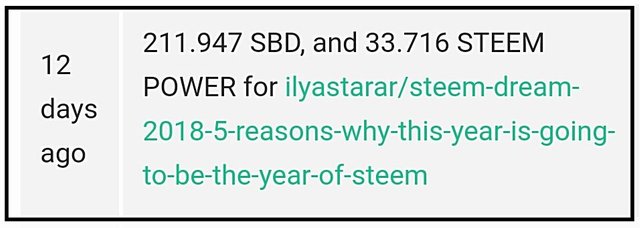
I hope this example has helped you see for yourself how payouts are finalized and how author rewards are distributed. Just one last clarification regarding author rewards.
Getting More than 75 % Share in Author Rewards?
If you see that the value of SBD and SP is more than 75 % of final payout, it is because you must have received a portion of curation reward as well. In such a case, curation rewards will be slightly less than 25 %, as in my post payout shown above. Curation rewards are discussed right below. Your share, however, will never be less than 75 % until policies are changed.
Choosing Payout Options
Let me explain the three payout options for you and share with you which one is profitable and under which circumstances.
1. Default (50 % / 50 %)
How this option works has already been well explained above. It is the most profitable option at the moment because the 50 % SBD portion is worth hundreds of dollars. When I received the payout of the example post, SBD was trading above $10 (meaning $2100+ value) and Steem was trading above $7 (meaning $230+ value). That's more than $2300 for a single post.
2. Power Up 100 %
If you use 'Power Up 100 %' option, all your post payout will be paid out as Steem Power as per the formula given above (in this example post, 75/4.95 = 15.15 SP) which is not profitable at all because you will get $75 worth of Steem only. Another downside of 100 % payout is that you get SP which is not liquid (immediately sell-able or transferable).
If I had chosen this option, I would have got just $471 value in form of 67.4 SP. Compare that with $2300+ I actually got.
Note:- Payout will still be distributed between author and curators (75 / 25 % ratio).
3. Decline Payout
If you choose Decline Payout option, your post will not receive any payout. Nothing will be added to your wallet. The amount corresponding to upvotes will still be shown in payouts but with a strike. Steemit official accounts and witnesses often use this option to keep the reward pool for their users and not take money out of it.
I used this option on two of my posts last week. You can see one of them here. I used the option because my post was not valuable enough to deserve any rewards and I just needed to pass on some information.
See the screenshot of a recent post by @ned for example. When I took the screenshot from his blog, I found an active post by @steemitblog which has declined payout. It shows a strike. Ned's post payout has been finalized therefore its shows $0.00 despite 332 upvotes. I remember this post having more than $800 showing.

"Ilyas, Tell Me Which Payout Option I Should Choose & Why!"
I prefer 50/50 payout because SBD gives me flexibility to trade it with Steem in the internal market, making profit in the process. Read this post for example and see what I am talking about. I sold Steem at 1.35 and bought back at 1.10 in the internal market. It was 22.7 % profit for me. Could have held on and buy back at 0.14 (89.63 % profit) but I didn't know that such a time will come.
1. When Steem is Under $1 But Higher in Value Than SBD...
You can choose Power Up 100 % because you will get more Steem. For $75 author share, you will get more than 75 SP. I don't know if Steem will ever go under $1 anymore but we all have seen craziest things happening in crypto so you never know.
2. If SBD is Higher in Value than Steem...
Choose Default (50 / 50) option because you will get liquid SBD which will have more value than the corresponding SP you will get.
3. When SBD is well over $1 (Like Now)...
Always go for Default (50 / 50) option. If there was a 100 % SBD option, I would use that in such a case because every $1 shown in the payout is worth $8.02 right now! The 37.5 SBD from a $100 payout means $300 right now!
In summary, Default (50 / 50) may prove to be a suitable option if used without switching to 100 % Power Up option. I have always used this option or declined payout.
How is Curation Reward Paid?
There needs to be a detailed post about how curation works (and there is) but here are some points pertaining to this blog post.
- Curation reward is paid in SP only. 25 % of payout amount goes to curators. But there are algorithms monitoring curation reward and they are more complex than author payout algorithm.
- If a post receives upvotes immediately after posting, nearly 100 % curation reward goes to the author; you. Curation reward keeps increasing up to 30 minutes.
- If it is upvoted 30 minutes after publishing, 100 % curation reward goes to the curator.
You can earn curation reward from others' posts as others can earn it from your posts. I haven't touched curation much due to the fact that @calamus056 has explained curation rewards in great detail. You must go through the post as it is one of the best resources on curation reward system.
With the major portion of this post on Steemit reward distribution system, I will share some useful information about reward system before concluding.
Important Information About Steemit Reward System
There are some things you should know and understand to make the best out of Steemit. Some of them are crucial.
1. Post Payout is Finalized in 7 Days
Every post or comment has exactly 6 days and 12 hours to get upvoted. It can be upvoted after that too but you won't get anything. After this period, post payout is calculated and then finalized upon completion of 7 days and rewards are sent to your wallet. Put your marketing efforts during these 7 days only.
One more thing I experienced is that if a post has been flagged and made hidden due to heavy downvote, it can be made visible only during the 7 days. Once this period is gone, no amount of upvotes can bring it back to visibility.
2. Value of Upvote Depends on Voting Power
If you have not voted for a single time, you have 100 % voting power left. With each full vote (100 % vote), your voting power reduces by 2 %. It means if you give 10 full votes per day, your end balance would be 80 % voting power. But at 80 % VP, the value of your upvote in terms of $ would also be 80 % of what it was when you had 100 % VP.
Note:- Voting Power keeps regenerating and it will go from 0 % to 100 % in 5 complete days (if not consumed through voting). So, as you vote the VP goes down but at the same time your VP also regenerates daily (20 % per day, 2 % in 2.4 hours) so there's nothing to worry about unless you are voting too many times.
3. Use SteemNow.com to See Your and Others' Vote Value & VP
SteemNow is a wonderful tool designed by @penguinpablo. I primarily used it to know my Reputation score but it is very useful for viewing yours and others' voting power and vote value. Here's my screenshot at the moment.
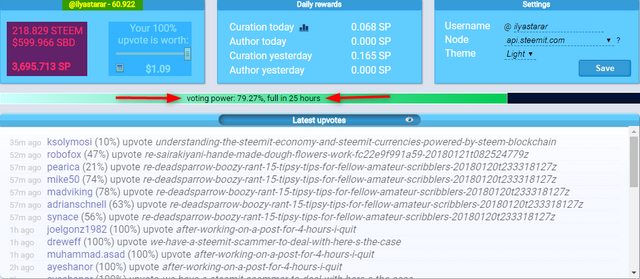
By scrolling down, you can also see you curation and outstanding post rewards.
4. Relation Between Reward System and Reputation Score
This is extremely important to know. Your reputation score tells you and others where you stand on Steemit. It is a good indicator of how hard you have worked, how much success you got and how much you have earned.
Your reputation score increases only when you receive an upvote having some value the increase in the reputation, which happens immediately, is directly proportional to the value of the upvote your post or comment receives.
Also know that going from number n to n+1 (i.e 35 to 36 for example) is more difficult than going from n-1 to n (34 to 36). To the point that going from 59 to 60 was more difficult for me to than going from 25 to 55.
Related Resource: Reputation Score 101 : What is Steemit Reputation Score, How is It Calculated and Why Should We Bother?
5. How is Your Account Value in USD Calculated?
If you look at your wallet, there's an amount called Estimated Account Value. It is calculated based on what you own in the wallet. Whatever amount of Steem, SP and SBD you have in the account adds towards the total value. However, SP delegated to you is not added or subtracted. Otherwise my account value would have $12000 more than it currently shows.
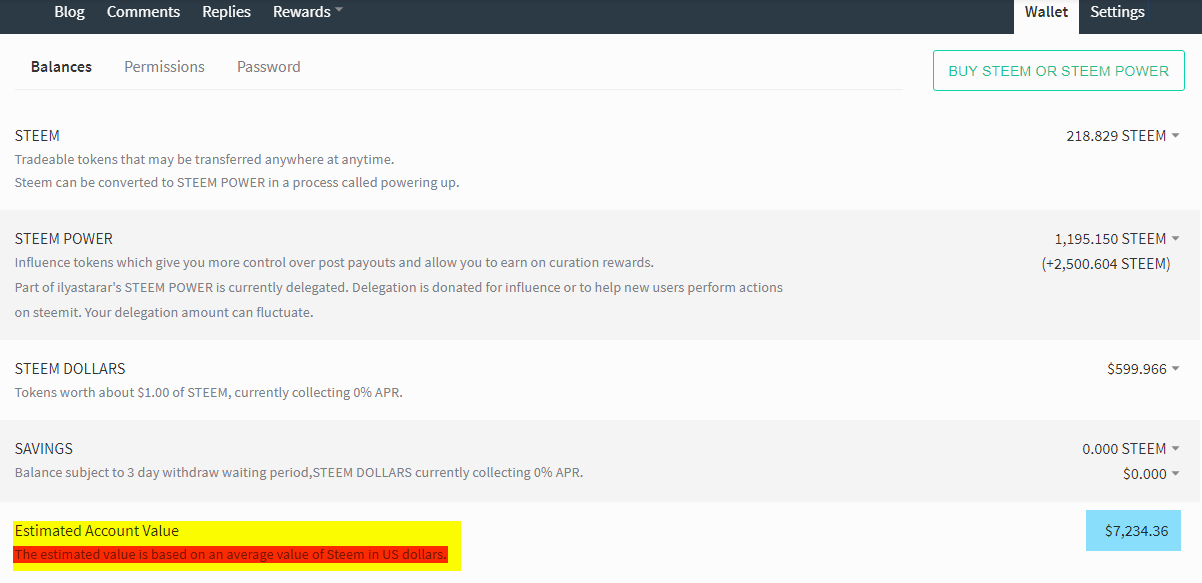
The value is not based on current price of Steem and SBD but the average price of last 7 days. So, the actual value of your holdings can be more or less than what is shown. My colleague and friend @jbn has covered the topic in detail. I am linking it for you.
Detailed Study: Your Estimated Account Value is Way More Than You Think It Is : Everything About Steem Wallet Value
6. Things You Can Do with Steemit Rewards
I compiled a list of 9 things you can do with Steemit rewards. People found it useful when I published it and I am sure you will find it useful too. I have since gained more insight and will publish an updated version of the things that can be done with Steemit rewards. It would be a super useful version and will take some time.
7. Steemit Rewards FAQ
I am including the Rewards FAQ post by @dragosroua, who simply answered the most frequently asked questions. Newbies should definitely read it up.
8. Where Do The 25 % Inflation Tokens Go?
We know that 75 % of inflation tokens come to reward pool. If you do not know this, do read the previous post that I linked in the beginning. But where do the other 25 % go? Let's see.
- 15 % tokens (of the remaining 25 %) are distributed to SP holders as an incentive to hold Steem in form of SP, which keeps the Steem supply limited and helps keep the token price up (demand and supply dynamics).
- 10 % tokens are distributed among Witnesses (people chosen by Steemians' vote to produce blocks of Steem blockchain, process Steem data and make important decisions pertaining to the blockchain).
9. Why is $ Sign Used?
Finally, let's discuss, and remove the confusion around it, why $ sign is used by Steemit and why Steem blockchain considers it the value equivalent to USD value of a post. We have already seen that 75 % of the final reward showed $423 but was actually worth more than $2300.
The answer lies in SBD. SBD is Steem Dollar and it was pegged to remain close to $1 in value. So, logically, Steem blockchain considered post payouts to be almost equal to the actually show amount. If SBD = $1, the whole consideration is 100 percent true. For a $100 payout, 37.5 SBD will mean $37.5 and the value of rewarded SP will also be exactly $37.5 (it still is). Curation rewards will also be equal to $25 in value.
So, the use of $ sign was logical until the price of SBD was pumped due to huge demand on the external exchanges. I hope the whole system is clear now. I have covered reward system earlier too but I admit that my understanding was limited in some aspects. This post was much needed because it contains updated and fairly accurate information. If you find an error, do let me know.
Conclusion
That's all about Steem economy and Steemit reward system. I hope this detailed post will help you understand the reward system better and use the information to your maximum benefit. This detailed analysis is part of my mission to leverage my brain to make Steemit the platform we all want it to be. I had covered Steemit economy and the reward system separately earlier due to the length. I intended to combine both and create a single resource to help people understand Steem's economy and the distribution system, hence this post.
If you have any question, do share it in the comments. It would be kind of you to support this post through your valuable upvotes and resteems. Helping this post with upvotes will not only benefit the community at large, but also will encourage me to put more effort into educating Steemians to create a better ecosystem on Steemit.
Wow, thank you @ilyastarar for clearly explaining so many confusing details about steemit!
Please write more about SP and delegating SP, as you said you would: "You can also get delegated SP but you do not own it. But it definitely increases the value of your vote. I will do a separate post on it too."
(sorry for quoting you like this, still haven't figured out how to do it properly...)
Also, I upvoted this post when you published it, and would like to know more about voting power. I noticed nothing changes when I upvote other people's posts, so I don't know... should I keep upvoting or wait till I have more voting power? Ah, so much to learn around here!
Thanks for helping!
This Magnum Opus should be a sticky on Steemit frontpage
I had to find the meanings in the dictionary to get what you have said. Thank you for such high praise!
Hello friend, you can support me with a good vote. I'll be grateful. It would be a great contribution.
Hi @vortac I totally agree with you! Its a great explanation of everything and worth reading! Thanks @ilyastarar !
By the way, I wanted to give you huge thanks for all the support on some previous posts some weeks ago.
I am sure you know about @steem-ambassador and #promo-steem , I have been creating some important shout outs to people on the blockchain, to see if we can get SP delegations for the guild. As of now we have 16 delegators with a total of over 26k SP delegated to it.
The last shout was to @therealwolf and you can check it here:
A Huge Shout to @therealwolf - This Time some Help to Get @freedom and @thejohalfiles attention regarding @steem-ambassador Guild and the Entire #promo-steem Project
Looking forward to your feedback when you get the chance!
Regards, @gold84
you need to update the parts about SBD prices, since they have dropped a lot since you wrote that.
ex: "every $1 shown in the payout is worth $8.02 right now", but a lot has changed.
upvoting myself so maybe you read this before editing is locked
I know. The screenshots I used are not current so I used old amounts as well. In a month or so, it won't matter much may be :)
But I'll figure these parts out and amend the calculations as well. Thank you :)
Currently author rewards are not only credited in SP and SBD, but also in STEEM as the SBD print rate dropped to about 90% because of the recent drop of the STEEM price.
Also author rewards may be less than 75% because of beneficiaries (e.g. if you post on utopian.io or dmania.lol).
For a detailed description of the payout process, you may look at my recent post: https://steemit.com/utopian-io/@nafestw/estimate-author-payouts-with-steem-js
You can also refer to http://deepsteem.com for an accurate estimate of your author rewards.
Thanks for the update regarding beneficiary cuts from rewards. As I was focusing on Steemit only, the information was not included. However, is important and I will add it to the post to make it more valuable.
Whoa, that was interesting, comprehensive and impressive! It took for a while to read it. I can imagine how huge work it was to write it, not mentioning the time-consuming information gathering before the post! Thank you @ ilyastarar, I think that was the more informative post on the topic I've ever read on steemit during my staying here. I'm sure that I will read it again a few times.
It would be nice to know the exact time windows of curation in the first 30 minutes. You wrote that 'Curation reward keeps increasing up to 30 minutes'.
I met the expression of STU (steem tocken unit) once, maybe in @dragosroua post. How does it fit into this currency system you described?
Thank you again, it's a great post, definitely worth for an upvote and resteeming!
Thank you for your feedback. I have linked to @dragosroua's post on SBD in this post as he's one of the best sources to learn from about the economics of Steem. The STU is short for Steem Token Unit. He's the developer of Steem.supply app and there's a rewards calculator on its site. The term comes from there. The explanation is given there if you open the link. STU is his own term.
I wish I was but I am not a programmer. Otherwise, I could have fetched the code and explained the Curation window to you. At the moment, 30 minutes and afterward is the time when upvotes bring maximum rewards (provided you are the earliest voter). Before that, every minute minuses a portion of curation rewards. This portion is added to the author rewards. If you vote the moment a post is published, there is zero curation reward.
20-30 minutes is thus the best time to vote on undervalued posts or the posts with low rewards at that time but expected to get bigger votes after yours. Again, 20 minutes will have a slight penalty and your curation reward will be less than 25 % of your vote value.
Note:- The curation reward system will be updated in the next fork and we will have a 15 minute window, instead of the current 30 minutes.
Thanks for the quick answers. It's really useful to know that the initial 30 minutes will be decreased to 15!
I impressed with the so much information you have shared here including the link to some author in order to complete your topics about steem economy esp for newbies like me. I am still struggling to understand but slowly will get through. However, I have one question to ask, how early is the earliest voter here? Thanks in adv ;)
If it helps here's also a great page that tells you how the dollar figure on the posts are worked out and calculator to work out how much you or someone else will actually get based on the current prices of SBD and STEEM in both USD and tokens:
http://steem.supply/rewards
Awesome. Thanks for linking in the comments. I mentioned it in reply to @gabeboy but having it in the main comments is great.
You're the real Steemit Guide Master! Great Educational Post that really sums a lot of information. Great for Beginners and existing Users
Thank you so much!!!
Re the 15 % tokens (of the remaining 25 %) are distributed to SP holders as an incentive to hold Steem in form of SP, which keeps the Steem supply limited and helps keep the token price up (demand and supply dynamics). part...
When/How is this distributed?
SP holders are paid interest as per their percentage share in the total vested Steem. How exactly, or when, that is done is in the code somewhere and I am not a programmer. Sadly so. :(
I will ask someone knowledgeable and let you know. It will help me clear this part as well. Thanks for raising the question.
Thanks... please do, and let us know when you do find out... I thought I read on one of the witness' posts that they've "set their "interest level to 0" because of the SBD and/or STEEM price (it went a little over my head at the time I read it, and I still meant to follow up on it, but haven't had a chance yet).
there is a sea of information here, super interesting, the economy of steemit is often complex for many, I want to ask you today about the steem I received today in some of my rewards, what does it mean??
I left a note in the post regarding this.
there are certain things I still don't digest well, thank you very much for answering :)
I linked whitepaper. Reading it might help :)
are helping me to translate one, I think the initial problem for me is that I don't speak English :(
If you are writing these comments on your own, I don't think English is a big problem.
I have a great ally www.deepl.com is a great tool for me, thank you friend
Extremelly useful information. I’ve been wondering all the time what is the difference between SBD and Steem. Now everything makes sense! Thanks for simply presenting this topics.